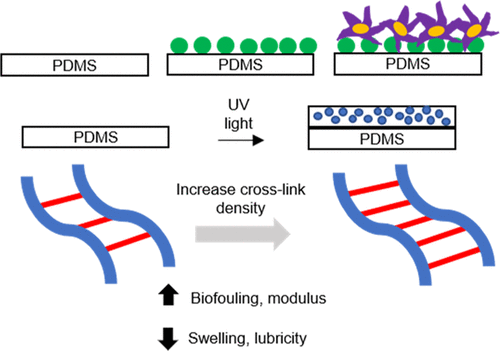当前位置:
X-MOL 学术
›
ACS Biomater. Sci. Eng.
›
论文详情
Our official English website, www.x-mol.net, welcomes your
feedback! (Note: you will need to create a separate account there.)
Antifouling and Mechanical Properties of Photografted Zwitterionic Hydrogel Thin-Film Coatings Depend on the Cross-Link Density
ACS Biomaterials Science & Engineering ( IF 5.4 ) Pub Date : 2021-08-04 , DOI: 10.1021/acsbiomaterials.1c00852 Megan J Jensen 1 , Adreann Peel 2 , Ryan Horne 1, 2 , Jamison Chamberlain 2 , Linjing Xu 1 , Marlan R Hansen 1, 3, 4 , C Allan Guymon 2
ACS Biomaterials Science & Engineering ( IF 5.4 ) Pub Date : 2021-08-04 , DOI: 10.1021/acsbiomaterials.1c00852 Megan J Jensen 1 , Adreann Peel 2 , Ryan Horne 1, 2 , Jamison Chamberlain 2 , Linjing Xu 1 , Marlan R Hansen 1, 3, 4 , C Allan Guymon 2
Affiliation

|
Zwitterionic polymer networks have shown promise in reducing the short- and long-term inflammatory foreign body response to implanted biomaterials by combining the antifouling properties of zwitterionic polymers with the mechanical stability provided by cross-linking. Cross-link density directly modulates mechanical properties (i.e., swelling behavior, resistance to stress and strain, and lubricity) but theoretically could reduce desirable biological properties (i.e., antifouling) of zwitterionic materials. This work examined the effect of varying poly(ethylene glycol) dimethacrylate cross-linker concentration on protein adsorption, cell adhesion, equilibrium swelling, compressive modulus, and lubricity of zwitterionic thin films. Furthermore, this work aimed to determine the appropriate balance among each of these mechanical and biologic properties to produce thin films that are strong, durable, and lubricious, yet also able to resist biofouling. The results demonstrated nearly a 20-fold reduction in fibrinogen adsorption on zwitterionic thin films photografted on polydimethylsiloxane (PDMS) across a wide range of cross-link densities. Interestingly, either at high or low cross-link densities, increased levels of protein adsorption were observed. In addition to fibrinogen, macrophage and fibroblast cell adhesion was reduced significantly on zwitterionic thin films, with a large range of cross-link densities, resulting in low cell counts. The macrophage count was reduced by 30-fold, while the fibroblast count was reduced nearly 10-fold on grafted zwitterionic films relative to uncoated films. Increasing degrees of cell adhesion were noted as the cross-linker concentration exceeded 50%. As expected, increased cross-link density resulted in a reduced swelling but greater compressive modulus. Notably, the coefficient of friction was dramatically reduced for zwitterionic thin films compared to uncoated PDMS across a broad range of cross-link densities, an attractive property for insertional implants. This work identified a broad range of cross-link densities that provide desirable antifouling effects while also maintaining the mechanical functionality of the thin films.
中文翻译:

光接枝两性离子水凝胶薄膜涂层的防污和机械性能取决于交联密度
通过将两性离子聚合物的防污性能与交联提供的机械稳定性相结合,两性离子聚合物网络已显示出减少对植入生物材料的短期和长期炎症异物反应的前景。交联密度直接调节机械性能(即溶胀行为、抗应力和应变能力以及润滑性),但理论上会降低两性离子材料的理想生物学性能(即防污性)。这项工作检查了不同聚(乙二醇)二甲基丙烯酸酯交联剂浓度对蛋白质吸附、细胞粘附、平衡溶胀、压缩模量和两性离子薄膜润滑性的影响。此外,这项工作旨在确定这些机械和生物特性之间的适当平衡,以生产坚固、耐用和润滑的薄膜,同时还能抵抗生物污染。结果表明,在广泛的交联密度范围内,在聚二甲基硅氧烷 (PDMS) 上光接枝的两性离子薄膜上的纤维蛋白原吸附减少了近 20 倍。有趣的是,无论是高交联密度还是低交联密度,都观察到蛋白质吸附水平增加。除纤维蛋白原外,巨噬细胞和成纤维细胞在两性离子薄膜上的粘附显着降低,具有大范围的交联密度,导致细胞计数低。巨噬细胞数量减少了 30 倍,而嫁接的两性离子薄膜上的成纤维细胞数量相对于未涂覆的薄膜减少了近 10 倍。当交联剂浓度超过 50% 时,注意到细胞粘附程度的增加。正如预期的那样,增加的交联密度导致溶胀减少但压缩模量增加。值得注意的是,与未涂覆的 PDMS 相比,两性离子薄膜的摩擦系数在广泛的交联密度范围内显着降低,这对于插入式植入物来说是一个有吸引力的特性。这项工作确定了广泛的交联密度,它们提供了理想的防污效果,同时还保持了薄膜的机械功能。交联密度增加导致溶胀减少但压缩模量增加。值得注意的是,与未涂覆的 PDMS 相比,两性离子薄膜的摩擦系数在广泛的交联密度范围内显着降低,这对于插入式植入物来说是一个有吸引力的特性。这项工作确定了广泛的交联密度,它们提供了理想的防污效果,同时还保持了薄膜的机械功能。交联密度增加导致溶胀减少但压缩模量增加。值得注意的是,与未涂覆的 PDMS 相比,两性离子薄膜的摩擦系数在广泛的交联密度范围内显着降低,这对于插入式植入物来说是一个有吸引力的特性。这项工作确定了广泛的交联密度,它们提供了理想的防污效果,同时还保持了薄膜的机械功能。
更新日期:2021-09-13
中文翻译:

光接枝两性离子水凝胶薄膜涂层的防污和机械性能取决于交联密度
通过将两性离子聚合物的防污性能与交联提供的机械稳定性相结合,两性离子聚合物网络已显示出减少对植入生物材料的短期和长期炎症异物反应的前景。交联密度直接调节机械性能(即溶胀行为、抗应力和应变能力以及润滑性),但理论上会降低两性离子材料的理想生物学性能(即防污性)。这项工作检查了不同聚(乙二醇)二甲基丙烯酸酯交联剂浓度对蛋白质吸附、细胞粘附、平衡溶胀、压缩模量和两性离子薄膜润滑性的影响。此外,这项工作旨在确定这些机械和生物特性之间的适当平衡,以生产坚固、耐用和润滑的薄膜,同时还能抵抗生物污染。结果表明,在广泛的交联密度范围内,在聚二甲基硅氧烷 (PDMS) 上光接枝的两性离子薄膜上的纤维蛋白原吸附减少了近 20 倍。有趣的是,无论是高交联密度还是低交联密度,都观察到蛋白质吸附水平增加。除纤维蛋白原外,巨噬细胞和成纤维细胞在两性离子薄膜上的粘附显着降低,具有大范围的交联密度,导致细胞计数低。巨噬细胞数量减少了 30 倍,而嫁接的两性离子薄膜上的成纤维细胞数量相对于未涂覆的薄膜减少了近 10 倍。当交联剂浓度超过 50% 时,注意到细胞粘附程度的增加。正如预期的那样,增加的交联密度导致溶胀减少但压缩模量增加。值得注意的是,与未涂覆的 PDMS 相比,两性离子薄膜的摩擦系数在广泛的交联密度范围内显着降低,这对于插入式植入物来说是一个有吸引力的特性。这项工作确定了广泛的交联密度,它们提供了理想的防污效果,同时还保持了薄膜的机械功能。交联密度增加导致溶胀减少但压缩模量增加。值得注意的是,与未涂覆的 PDMS 相比,两性离子薄膜的摩擦系数在广泛的交联密度范围内显着降低,这对于插入式植入物来说是一个有吸引力的特性。这项工作确定了广泛的交联密度,它们提供了理想的防污效果,同时还保持了薄膜的机械功能。交联密度增加导致溶胀减少但压缩模量增加。值得注意的是,与未涂覆的 PDMS 相比,两性离子薄膜的摩擦系数在广泛的交联密度范围内显着降低,这对于插入式植入物来说是一个有吸引力的特性。这项工作确定了广泛的交联密度,它们提供了理想的防污效果,同时还保持了薄膜的机械功能。









































 京公网安备 11010802027423号
京公网安备 11010802027423号